Our pellet grill pulled pork method will help you make a perfectly smoked, super tender, mouthwatering pork butt. If you’re a fan of smoked pulled pork but want to sharpen your Pitmaster skills, follow our step-by-step recipe guide for the best tips and tricks. Master the art of preparing the perfect BBQ pork using your pellet grill.

derrickriches.com
Smoked Pulled pork is a classic American BBQ dish cooked low and slow over charcoal, hardwood, or in a pellet smoker. It is a staple of backyard BBQs, tailgating events, and weekend meals. In this recipe guide, you will learn the ins and outs of smoking pork shoulder, starting with an injection marinade and then adding a generous dose of seasonings to create a beautiful bark on the roast’s surface. Plan on a cooking time of 7-10 hours or more for a 6-8 pound pork roast. And remember that time is just an estimate; the best guide is the internal temperature of the meat.
Why use a pellet grill for smoked pulled pork?
Cooking pulled pork on a pellet grill is incredibly easy and convenient, producing a moderate smoky flavor without the extra effort. This technique is best suited for beginners, as using a pellet grill will make the process straightforward, convenient, and enjoyable.
What is the difference between a pork butt and a pork shoulder?
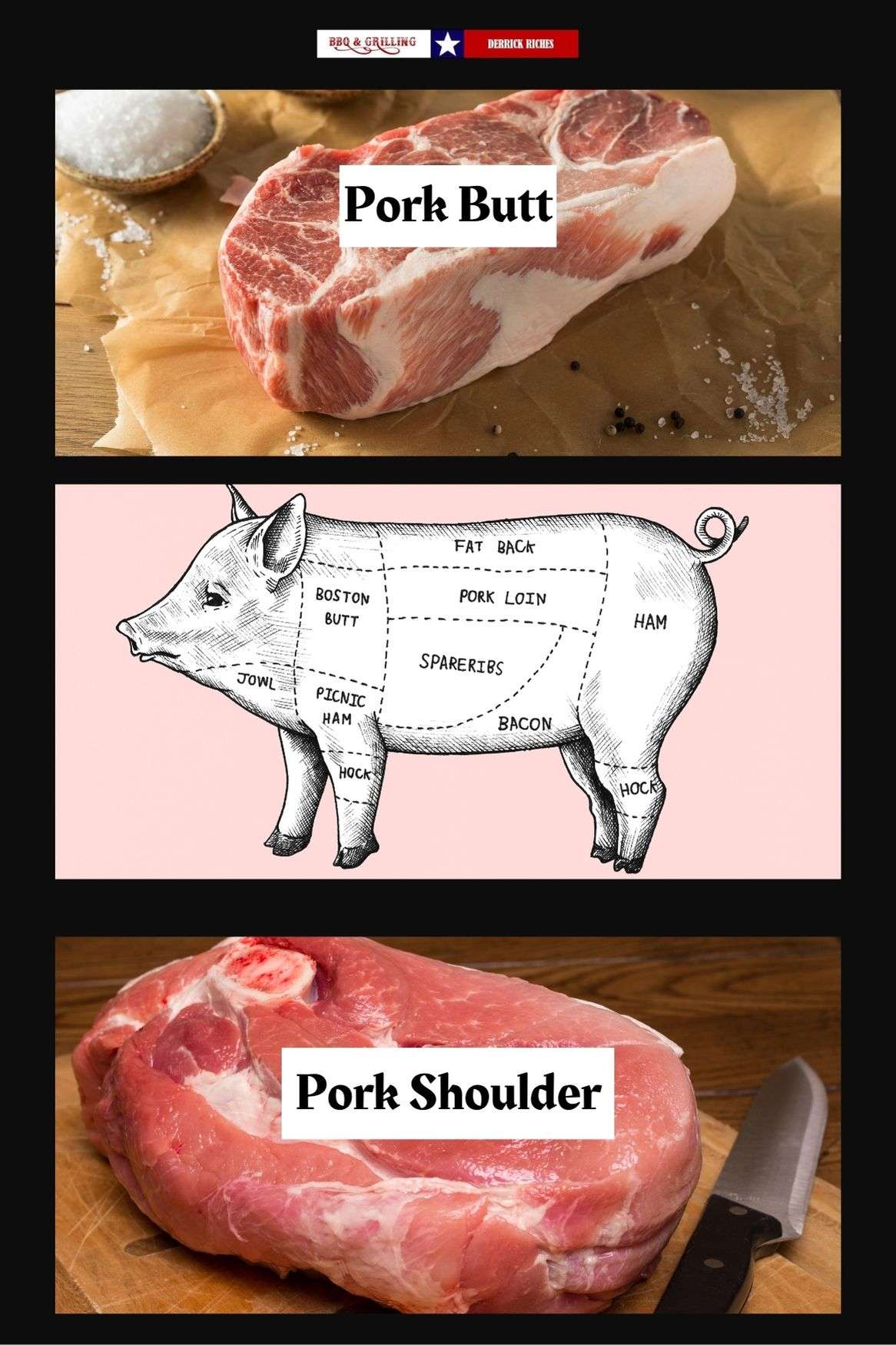
Both cuts of meat come from the shoulder area of the pig. However, the pork butt (also known as the Boston butt or shoulder butt) is located higher up on the animal, while the shoulder (also referred to as a picnic roast) runs further down. Although these two cuts originate from the same area, they differ in use. Both benefit from long, low, and slow cooking, with pork butts being the better choice for novice cooks. Pork shoulder can contain skin, making it an ideal cut for pork crackling recipes. You can use either roast to make pellet grill pulled pork.
Where do you find a pork butt?
You can source pork butt (or shoulder) in most grocery stores, source it from a local butcher or an online meat purveyor like Porter Road. The current cost per pound in some areas is $2.00 to $3.50 per pound. Online specialty pork butts typically cost $5.80 or more per pound. These prices will fluctuate based on the cost of living in your area.
How much pulled pork to serve per person?
Plan on 1/2 of a pound of meat per person. For guests with smaller appetites, plan on 1/3 of a pound per person. It’s always safer to overestimate rather than underestimate the amount needed. If you have leftovers, you’ve planned correctly! A 5-pound pork butt typically yields about 3 pounds of meat. Refer to the table below for specific recommendations.
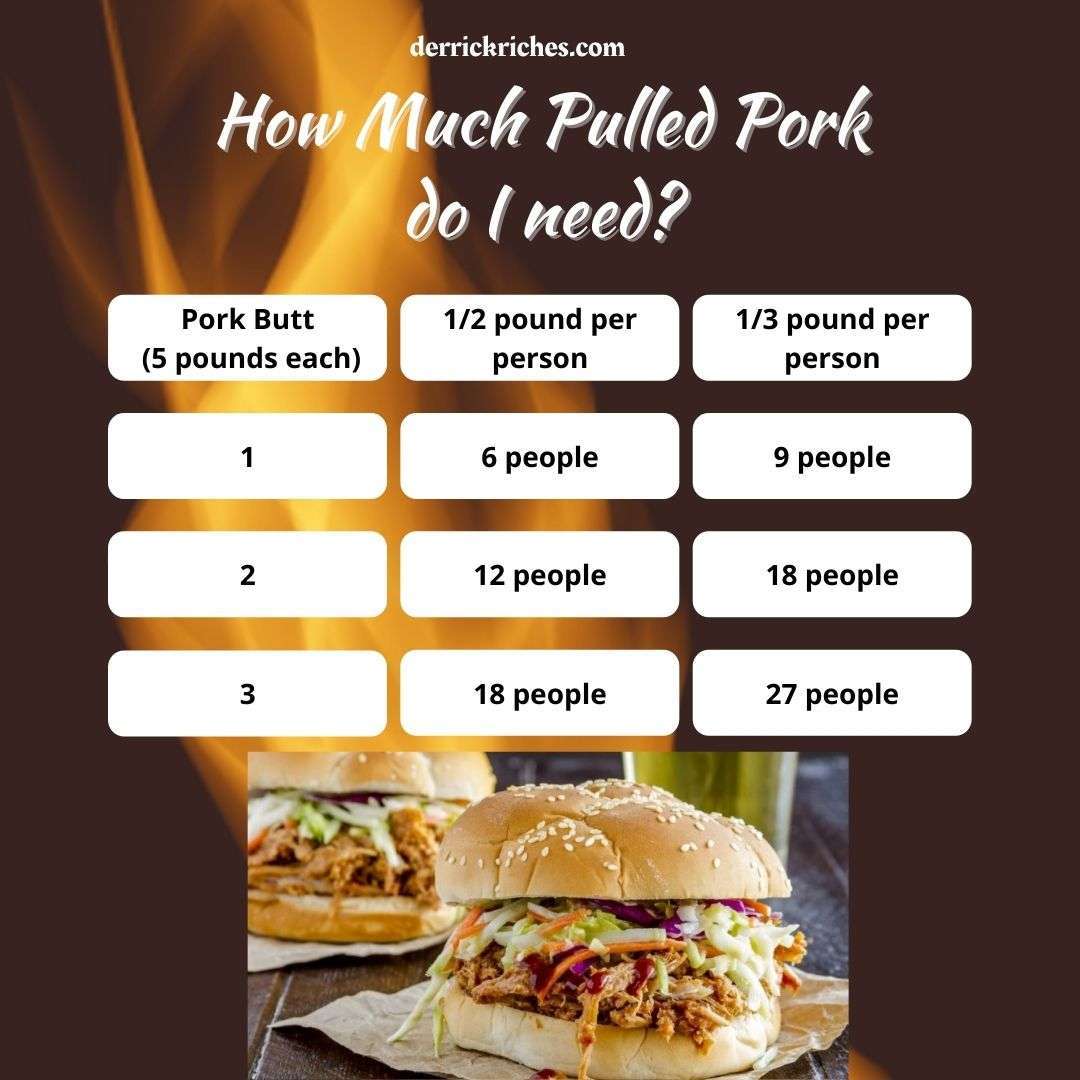
Time, Temperature, and Fuel
- Time: Plan on 7-10 hours of cooking time for a pork butt that weighs between 6-8 pounds.
- Fuel: We recommend taking an inventory of your current fuel supply. Do you have enough wood pellets to get you through a 7-10 hour cook? If you don’t have enough, it’s time to replenish your wood pellet supply. There’s nothing more frustrating than running out of fuel in the middle of cooking!
- Temperature: Start at 225°F and increase to 275°F toward the end of cooking. Have a temperature monitoring device, instant-read meat thermometer, or a temperature probe nearby. You’re going to need it!
- Doneness: Pulled pork is considered done once it reaches an internal temperature between 195-205°F.
- REST THE MEAT! Rest smoked pork for 45-60 minutes. Doing so gives the roast enough time to relax, redistribute juices, and increase tenderness – all of which help with the “pulling” process.
What wood is best for pulled pork?
- We recommend using apple, cherry, maple, or pecan wood for this recipe. For a more robust smoke flavor, use hickory.
Trimming a Pork Roast
- Trim the excess fat cap down to 1/4 of an inch. Do not worry about intramuscular fat (marbling). You want that to stay right where it is.
- Scoring the fat cap: Some cooks choose to score the fat cap for several reasons. First, it helps the fat render during cooking. First, scoring helps the fat render more effectively during cooking. Second, it adds a decorative touch, and third, it allows the rub to penetrate deeper into the cracks and crevices. Please note that this step is optional.
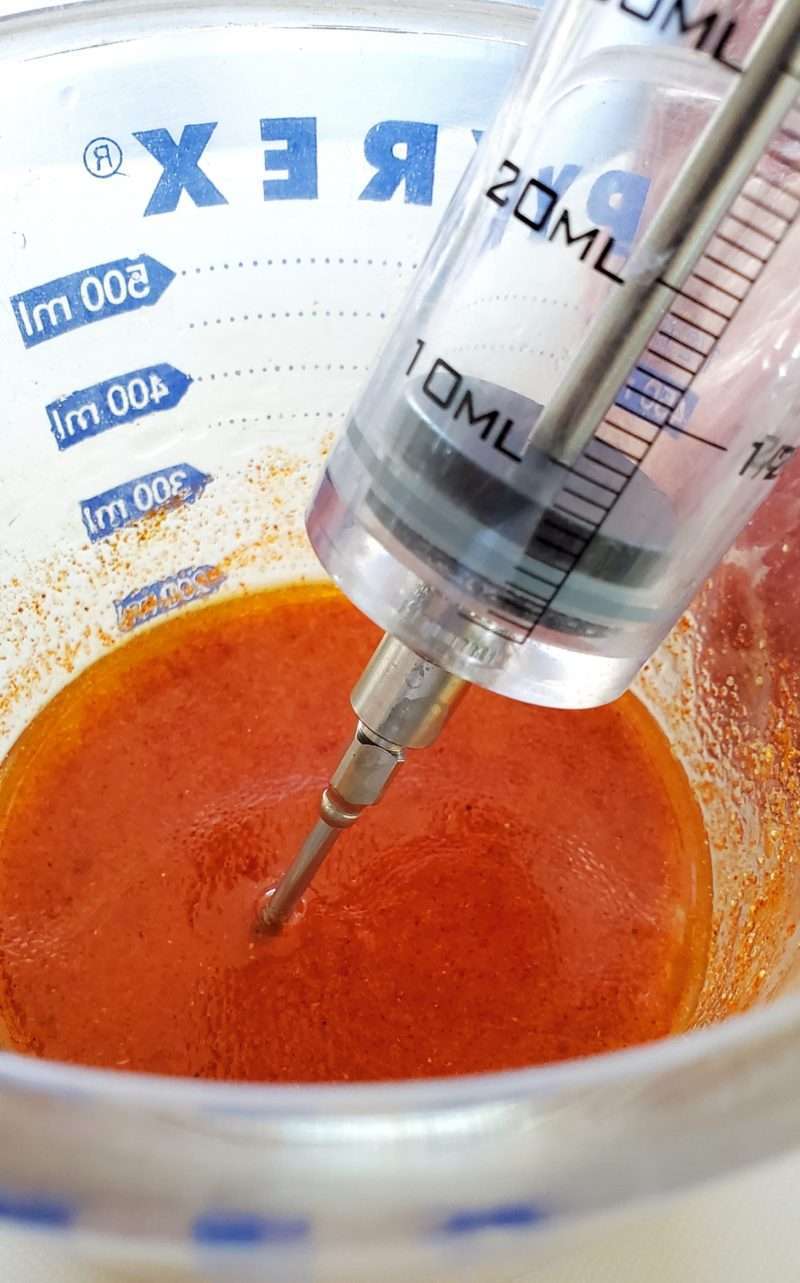
derrickriches.com
Using a Pork Injection Marinade
Using a pork injection marinade helps to flavor and moisten the roast from the inside out. Pork butts are large hunks of meat that require several hours of cooking. A rub will season the surface only. For that reason, we inject the roast with a flavorful mixture 4-12 hours before cooking it. Some of our favorite marinade recipes include the Cajun Injection Marinade or Basic Pork Injection. If you do not have an food-safe meat injector, don’t worry. You can purchase them at hardware stores, some supermarkets, or online.

Flavoring Pulled Pork
The key to delicious pulled pork comes from layering the flavor. The first layer happens internally from using an injection marinade. The second layer is applied externally and includes simple rubs like SPG or more complex BBQ rubs for pork. SPG is a simple salt, black pepper, and garlic powder mixture, while a BBQ Rub imparts a little sweetness and heat to the roast. You can use whichever combination you’d like, but the goal is to build a flavorful bark. Feel free to use your favorite bottled rub or our Memphis Dust Rub, but remember that if you plan to use more than one rub, the flavors should complement each other and not overpower one another.
Should I use a binder before applying the rub?
That depends entirely on personal preference. We recommend trying one with and without to see which one you prefer. Below are some of our favorite binders to use.
- Mustard: Pork roasts are often coated with yellow mustard before it is seasoned. The binder keeps the seasonings in place and adds an extra layer of flavor as the meat cooks. It’s important to note that the smoked pork will not taste like mustard; instead, it will blend with the meat’s natural flavors, the seasoning rub, and the smokiness from the cooking process.
- Mustard and Worcestershire sauce: Combine 1/3 cup Worcestershire sauce with 3 tablespoons of yellow mustard and apply it to the whole roast.
- Hot Sauce: For added spiciness, lightly coat the roast with hot sauce like Frank’s Red Hot or Sriracha. Pair this binder with a sweet rub.
- Fats: Use olive oil or duck fat in small amounts. Using too much could potentially block smoke absorption. Aim for 1 to 1 1/2 tablespoons for a 5-6 pound roast.

derrickriches.com
Wrapping Smoked Pork: Butcher Paper vs. Aluminum Foil
Pink butcher paper and aluminum foil both serve the same purpose. They help the meat work through the stall in a sealed, moistened environment. However, there is one key difference. Butcher paper allows smoke to permeate the meat, keeping the bark intact, while the foil blocks it out and steams the pork. While recommend wrapping smoked brisket in butcher paper but prefer to wrap smoked pulled pork in aluminum foil and place it in a disposable pan. See below for details. Please keep in mind that this is our preference, and you can certainly wrap your pork roast in pink butcher paper.
Ingredients
Making Pulled Pork on a Pellet Grill
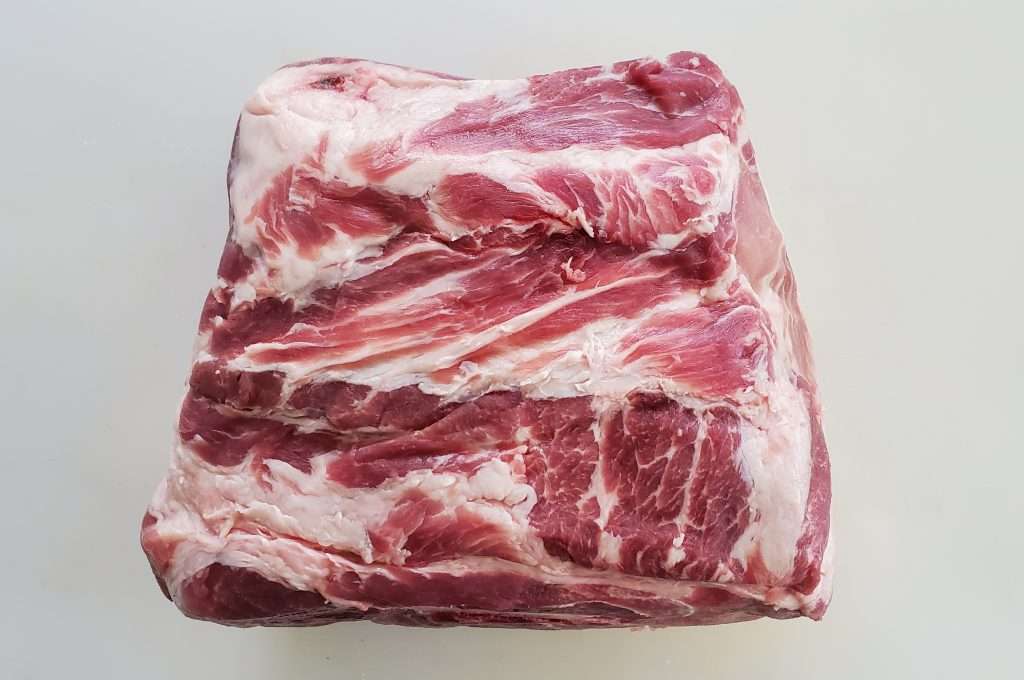

derrickriches.com
- Trim: Remove excess knobs of fat and reduce the fat cap to 1/4″ thick.
- Injection: Combine injection ingredients and slowly inject the pork roast with marinade. Wipe away any spillage with paper towels. Wrap tightly with plastic wrap and place pork butt into the refrigerator for 4-12 hours.


derrickriches.com
- After the pork has marinated, remove it from the fridge, and unwrap it.
- Optional step 1: Score the fat cap of your pork butt with a sharp knife.
- Optional step 2: Apply a thin coating of mustard or mustard-Worcestershire sauce mixture to the pork roast.
- Rub: Next, season pork with SPG rub first, then coat it with the Honey BBQ Rub. Let the meat stand at room temperature while you prepare your grill.
Set up and Smoking
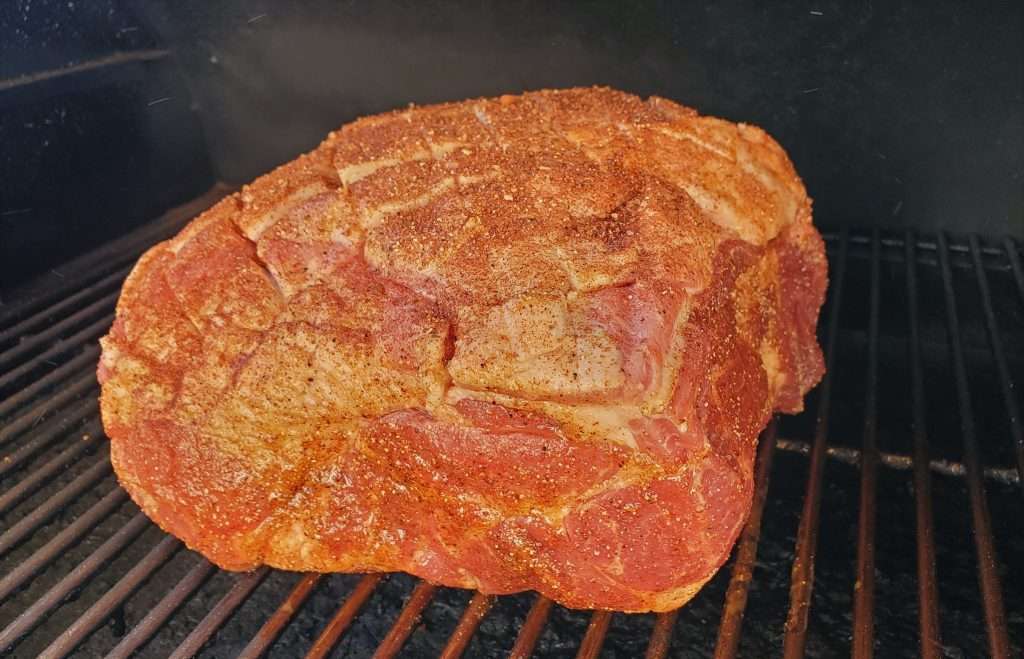
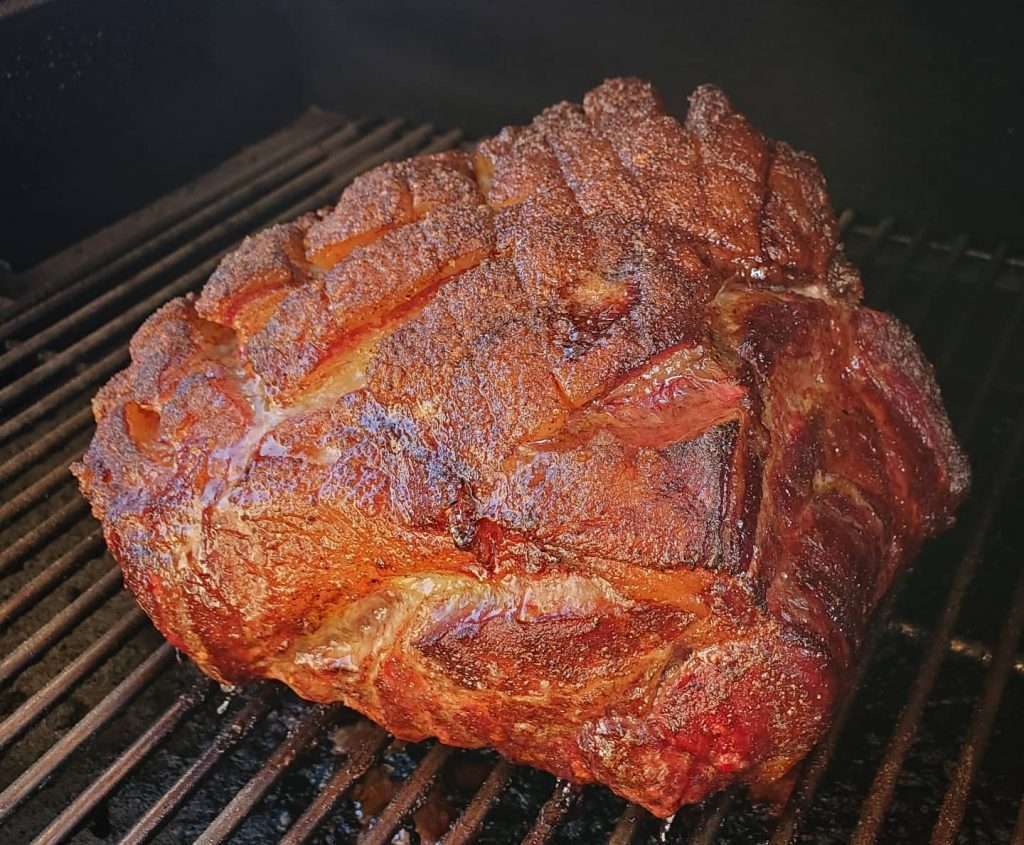
derrickriches.com
- Preheat your pellet grill to 225°F.
- Estimate cooking time: Plan on anywhere from 5-8 hours or 1 hour per pound of meat. This is a very rough estimate, as each pork roast cooks differently. The most important rule of good smoked pulled pork is not to rush the process.
- Cooking: Once your pellet grill reaches 225 degrees F, place the seasoned pork butt on the grill grates, fat side up. Close the lid and cook for 4 hours or until the pork reaches an internal temperature of 165°F.
Wrapping and End Stage Cooking:

Adding liquid to pork
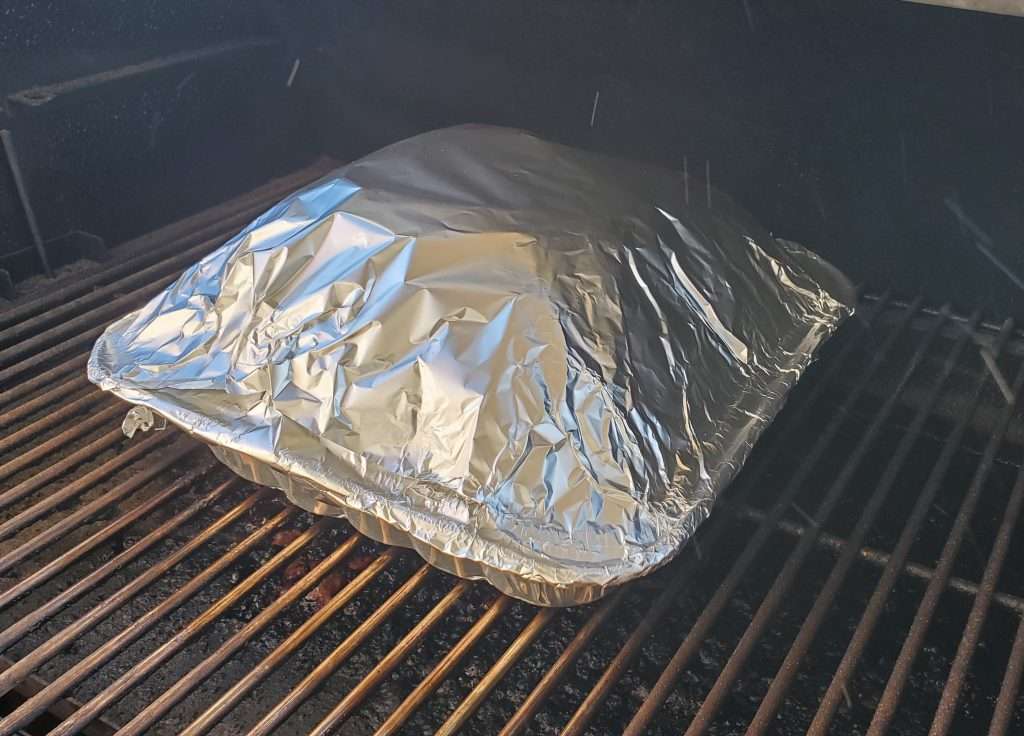
Wrapped
derrickriches.com
- Place it in a pan: Remove your pork butt from the pellet grill and place it into a disposable aluminum pan.
- Increase the heat of your pellet smoker to 275°F
- Add liquid and wrap: Add 1/3 cup of apple juice to the pan. Wrap the pan tightly with foil and return it to the smoker.
- Monitor the temp: Once the internal temperature of the meat reaches 195-205°F, your pork roast is done.
- Rest the pork: Remove pan from your pellet grill. Leave the pork wrapped and cover the foil with dry kitchen towels to keep it warm. Let the pork rest for 45 minutes to 1 hour. If you need to rest it longer, leave it wrapped and place it into a clean cooler for 2-3 hours. Insulate the roast with more towels.
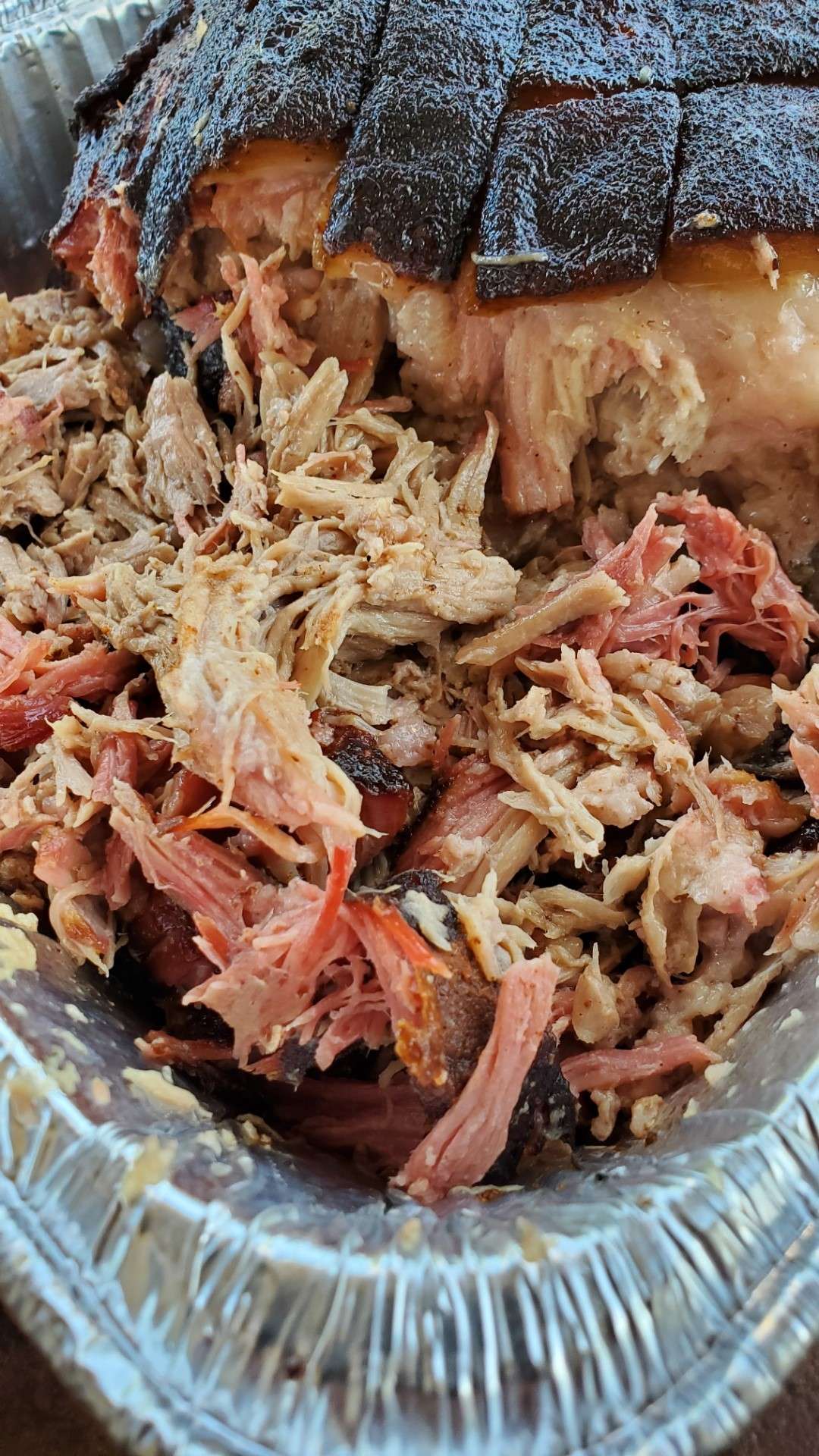
derrickriches.com
Pulled Pork: Resting and Pulling
- Unwrap the pork. If there is a lot of liquid in the pan, drain it into a bowl or liquid measuring cup. Reserve it. You will need the juices later on. Use heat resistant-food safe gloves for “pulling” the pork.
- Remove the large bone from the pork butt and any large clumps of fat.
- Break apart the meat, and hand pull the pork. Most of the roast will be incredibly tender and require little effort. You can also use the two-fork method for uniform shreds.
- Add remaining reserved juices as needed. Pat yourself on the back, you’ve now made pulled pork on a pellet grill!
- Serve with your favorite BBQ sauce in pulled pork sandwiches with coleslaw, BBQ sauce, and sliced onion. Or, serve with Hot Cheeto Queso Mac and Cheese on the side!
- Place it in a warmer: If serving for a long duration, consider placing your pulled pork in a warmer, with extra pulled pork jus.
- Store leftovers in an airtight container in the refrigerator for up to 4 days.
What are some flavor variations for pulled pork?
There are many ways to add flavor variation to pulled pork. The ones listed below are some of our favorite alternatives, but you can certainly experiment and develop something best suited to your needs.
Summary
We have tested this method and a recipe for Pulled Pork on various pellet grills, including Traeger, Pit Boss, Grilla, and Green Mountain Grills. We have not found any modifications needed for different makes or models.
What to Serve With Pulled Pork

Leftover Recipes!
Print
Pellet Grill Pulled Pork
If you're a fan of smoked pulled pork but want to sharpen your Pitmaster skills, follow our step-by-step recipe guide for the best tips and tricks.
Course Main Dish
Cuisine American BBQ
Keyword pellet grill pulled pork, pulled pork, smoked pork butt, smoked pork shoulder
Prep Time 35 minutes minutes
Cook Time 8 hours hours
Total Time 8 hours hours 45 minutes minutes
Servings 10 servings
Calories 230kcal
Author Derrick Riches and Sabrina Baksh
- 1 pork butt: about 6-8 pounds
- 1/4-1/2 cup Optional Coating: mustard or mustard and Worcestershire sauce
- Garlic-Maple Pork Injection
- 2 tablespoons SPG Rub
- 2-3 tablespoons Honey BBQ Rub
- 1/3 cup Apple juice
- Aluminum foil or peach butcher paper
- 1 Disposable aluminum pan 9″ x 9″
Remove excess knobs of fat and reduce the fat cap to 1/4″ thick.
Combine injection ingredients and slowly inject the pork roast with marinade. Wipe away any spillage with paper towels. Wrap tightly with plastic wrap and place pork butt into the refrigerator for 4-12 hours.
After the pork has marinated, remove it from the fridge, and unwrap.
Optional step 1: Score the fat cap of your pork butt with a sharp knife.
Optional step 2: Apply a thin coating of mustard or mustard-Worcestershire sauce mixture to the pork roast.
Rub: Next, season pork with SPG rub first, then coat it with the Honey BBQ Rub. Let the meat stand at room temperature while you prepare your grill.
Preheat your pellet grill for 225 degrees F.
Plan on anywhere from 7-10 hours or roughly 1 hour per pound of meat. This is a very rough estimate, as each pork butt cooks differently. So, we advise going into this with an open mind. You might have the perfect pulled pork in 7 hours, or it might take 10 hours. The most important rule of good BBQ pork is not to rush the process.
Once your pellet grill reaches 225 degrees F, place the seasoned pork butt onto the grill, scored side up. Close the lid and cook for 4 hours until it reaches an internal temperature of 165 degrees F.
Remove your pork butt from the pellet grill and place it into a disposable aluminum pan.
Increase the heat of your pellet smoker to 275 degrees F.
Add roughly 1/3 cup of apple juice to the pan. Wrap the pan tightly with foil and return it to the smoker.
Once the internal temperature of the meat reaches 195-205 degrees F, your pork butt is done.
Remove the covered smoked pork from your pellet grill. Leave it wrapped and cover it with dry kitchen towels to keep it warm. Let the pork rest for 45 minutes to 1 hour. If you need to rest it longer, leave it wrapped place it into a clean cooler for 2-3 hours. Insulate the with towels.
Once rested, unwrap the pork. If there is a lot of liquid in the pan, drain it into a bowl or liquid measuring cup. Reserve it. You will need the juices later on.
We recommend using heat resistant-food safe gloves for “pulling” the pork.
Remove the large bone from the pork butt and any large clumps of fat.
Break apart the meat, and hand pull the pork. Most of the roast will be incredibly tender and require little effort. You can also use the two-fork method if preferred.
Add remaining reserved juices as needed and serve immediately.
If serving for a long duration, consider placing your pulled pork in a warmer, with extra pulled pork jus.
Store leftovers in an airtight container in the refrigerator for up to 4 days.
Calories: 230kcal | Carbohydrates: 3g | Protein: 22g | Fat: 8g | Saturated Fat: 3g | Polyunsaturated Fat: 1g | Monounsaturated Fat: 4g | Trans Fat: 0.001g | Cholesterol: 74mg | Sodium: 154mg | Potassium: 415mg | Fiber: 1g | Sugar: 1g | Vitamin A: 89IU | Vitamin C: 1mg | Calcium: 50mg | Iron: 3mg
The post Pellet Grill Pulled Pork appeared first on BBQ & Grilling with Derrick Riches.
Did you miss our previous article...
https://manstuffnews.com/backyard-grilling/gochujang-baby-back-ribs
 Backyard GrillingWeekend WarriorsAdvice from DadBeard GroomingTV Shows for Guys4x4 Off-Road CarsMens FashionSports NewsAncient Archeology World NewsPrivacy PolicyTerms And Conditions
Backyard GrillingWeekend WarriorsAdvice from DadBeard GroomingTV Shows for Guys4x4 Off-Road CarsMens FashionSports NewsAncient Archeology World NewsPrivacy PolicyTerms And Conditions
